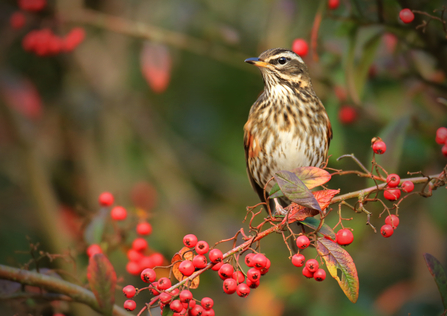
A large fly agaric fungus mushroom at BBOWT's Snelsmore Common nature reserve. Picture: Sally Smith
A pair of parasol mushrooms / fungi at BBOWT's Moor Copse nature reserve. Picture: Colin Williams

A large fly agaric fungus mushroom at BBOWT's Snelsmore Common nature reserve. Picture: Sally Smith
October is the prime time of year to see fantastic fungi at BBOWT nature reserves, and the star of the show is quite possibly the fabulous fly agaric. This species produces the iconic toadstool of fairytale and legend with its glistening red cap and white freckles, usually found growing beneath birch, spruce and pine trees in woodland. Find them at our Snelsmore Common reserve near Newbury which is a treasure trove for mushrooms at this time of year.

A pair of earth star fungus fruiting bodies at BBOWT's Warburg Nature Reserve. Picture: Hugh Weldon
Collared earth stars are one of our most weird and wonderful fungi. Emerging from the soil as little brown bulbs, they burst open into a star shape with the round fruiting body at their centre. This ball has a tiny hole called the peristome, and when raindrops land on the fungus it releases a puff of spores into the air. We found some fantastic specimens growing under the beech trees at our Warburg Nature Reserve near Henley this week.

Wood ear fungus sprouting out of a living tree. Picture: Pete Hughes
One of our most famous fungi, the wood ear's jelly-like lobes can be found sprouting out of dead logs and living branches in damp woodland. Also known as the jelly ear, it often emerges in tightly-coiled brains that inflate to their characteristic half-moon shape. This species is particularly popular in Chinese cuisine, but we never recommend foraging without an expert and we don't allow any picking on our nature reserves. Find out more:

A parasol mushroom (Macrolepiota procera) at BBOWT's Moor Copse nature reserve. Picture: Tom Hayward
Stroll through the grass at our Moor Copse reserve near Reading this month and you've got a good chance of spotting a little gang of parasols. These attractive fungi have broad, beige caps that can grow up to 25cm in diametre, covered in little brown scales. The stems beneath have a brown, snake skin-like pattern and can grow up to 30cm tall. Please let us know if you find one!

Panther cap fungus mushrooms at BBOWT's Warburg Nature Reserve. Picture: Kathryn Sheffield
Last October, our membership officer Kathryn was delighted to stumble on a little cluster of mushrooms at Warburg that she had never seen at the reserve before: panther caps. A close relative of fly agaric, this species also has white spots on its cap, but the base colour is a deep chestnut. Look out for them growing under beech trees at our Hog and Hollowhill Woods near Marlow.

Turkey tail. Photo by Les Binns
The turkeytail is a small, tough, bracket fungus that grows in tiered layers on dead wood - mainly beech or oak. It is very common and can be found throughout the UK on rotting stumps and branches. It is distinguished from other brackets by its surprising range of colours, appearing in rainbow stripes and ranging from purples and reds to yellow and green - reminiscent of a turkey's tail.

The jelly-like bowls of peziza vesiculosa fungus sprouting from the side of a damp haystack. Picture: Pete Hughes
Peziza vesiculosa, also known as the blistered cup fungus, is definitely one of our strangest-looking species. We found an outcrop last October sprouting 10 feet in the air from the side of a damp haystack. The fruiting bodies are hollow jelly balls with little holes in the top. Look out for them popping out of dung heaps and rotting straw.

The translucent mushrooms of porcelain fungus growing out the side of a living tree at BBOWT's Warburg Nature Reserve. Picture: Kathryn Sheffield
One of our most attractive mushrooms is the porcelain fungus: sprouting from the sides of living and dead beech trees in summer and autumn, the caps are pale, translucent and shiny. Seen from beneath in a sun-dappled woodland, they glow like a stained-glass window. We found the ones above at our Warburg Nature Reserve near Henley.

A cluster of shaggy scalycap mushrooms / fungus at BBOWT's Snelsmore Common reserve. Picture: Colin Williams
While the most attractive thing about many mushrooms is their appearance, many also have distinct scents as well! Our ecologist Colin found a beautiful little troop of shaggy scalycap at Snelsmore Common last October and reported that they did indeed have a radish-like smell which the species is famous for.
If you'd like to learn more about fungi, join our fungi walk at Windsor Great Park on Friday, 6 October.

Redwing by Jon Hawkins - Surrey Hills Photography
Of course, there are also loads of other wild highlights to look out for this month as well, including hedgehogs fattening up for the winter, ivy bees gathering the last pollen and nectar and the arrival of winter migrant birds such as the redwing.
Wrap up warm, keep your eyes peeled, and let us know what you spot!
Sign up below to receive the latest news from BBOWT, tips about how you can help wildlife, plus information on how you can get involved.